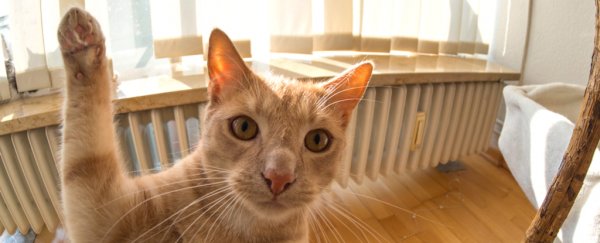New research has confirmed that cats have a preference when it comes to using their left or right paw, just like us humans with our left- and right-handedness.
There seems to be a gender link, too. According to the new study, female felines prefer using their right paw to reach for a tasty morsel of food or to venture down a step, while males prefer using their left paw.
The research backs up previous studies that have identified certain paw preferences in cats, and according to the team from Queen's University in Belfast in the UK, it might have something to teach us about the brain structures of our furry friends.
"The findings point more and more strongly to underlying differences in the neural architecture of male and female animals," says one of the researchers, Deborah Wells.
Unlike previous studies on paw preference, which were carried out in controlled lab conditions, this analysis took place in the cats' own homes as they did everyday tasks, covering 24 males and 20 females in total.
While the left and right bias for male and female cats was observed when they were using their paws for a range of natural behaviours, no such bias was spotted while the animals were sleeping – in other words, they had no preference for lying on their left or right side.
What's more, there was no overall preference for the left or the right as there is in humans, where around 90 percent of our species' population is thought to be right-handed.
The felines' paw preference for the left or right varied based on what they were doing: 73 percent showed a bias when reaching for food, 70 percent when stepping down on to something, and 66 percent for stepping over something.
Perhaps these preferences can give us an indication of how well our pets could respond to stress, suggest the researchers – remember that it's the left side of the brain that controls the right side of the body, and vice versa.
"Left-limbed animals, which rely more heavily on their right hemisphere for processing information, tend to show stronger fear responses, aggressive outbursts, and cope more poorly with stressful situations than animals that are right-limbed and rely more heavily on their left hemisphere for processing," Wells told Nicola Davis at The Guardian.
The cats had all been spayed and neutered before the experiments began, but the researchers aren't ruling out hormones as the reason for why some cats put their left paw forward and some their right. Which paw your pet uses could also help you understand how it deals with stress.
"There is some suggestion that limb preference might be a useful indicator of vulnerability to stress," says Wells.
"Ambilateral animals with no preference for one side or the other, and those that are more inclined to left-limb dominance, for example, seem more flighty and susceptible to poor welfare than those who lean more heavily towards right limb use."
Previous research with dogs has also shown a paw preference, in addition to revealing that left-pawed canines seem to be more pessimistic – that is, slower to reach towards food. That could be useful knowledge for anyone who cares for a pet.
The next time your dog or cat wanders by looking for a feed, you might want to look out for a paw preference. Why this develops though, remains a mystery.
"What is explaining this difference, we just don't know," Wells told The Guardian. "There is something going on with differences between the brain structure and function, clearly, of male and female animals, but as to the specifics, we just don't know yet."
The research has been published in Animal Behaviour.
